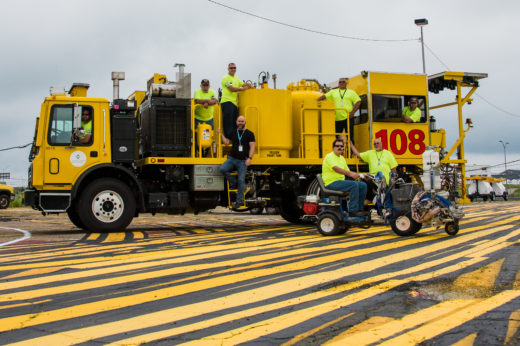Walking a Fine Line: Paint Crew Strives for Perfection
Keeping runway markings flawlessly straight and clear takes a lot of concentration – and caffeine
By Matt Neistei
Published August 19, 2019
Read Time: 4 mins
The 40-foot truck trudges along at about 5 mph in an unerringly straight line.
Brian West sits in the driver’s seat, occasionally using a laser sight to keep the rig pointed in exactly the same direction. He chats by radio with Phil Jandrokovic, who sits in a booth at the rear of the truck with his head hanging out the window, staring intently at the ground, where a sprayer is laying down a stripe of white paint only a few inches wide.
Mile after mile, the big yellow truck moves at a walking pace while West and Jandrokovic never take their eyes off the task. They do this for hours in the summer heat, day in and day out.

Large illuminated “X” signs are used as a safety precaution when runways are closed for painting. (Photo by Beth Hollerich)
Welcome to the Pittsburgh International Airport paint crew.
West and Jandrokovic are among a team of seven men whose primary job from about April to November is to paint every marking on airport property. Roads, parking lots, curbs – any paint that goes on any pavement is laid down by the paint crew.
“We could easily do multiple miles in a day,” West said.
Down to the inch
By far, their most important responsibility is the airfield. All markings on the runways, taxiways and ramps are very closely monitored by the Federal Aviation Administration, which measures two-mile-long lines down to the inch. Any deviation from strict federal policies means the entire job must be done over again.
Even the paint itself must be created to exact specifications. Tiny glass beads are mixed with the pigment during spraying to give markings a reflective quality for night operations. And the FAA will measure that quality with a refractometer to make sure it’s within standards.

The paint crew uses a variety of nozzles, paints and other equipment to accommodate the many different types of lines and markings they must spray. (Photo by Beth Hollerich)
If it’s not, start over again.
So what’s it like having to be nearly perfect with more than 20,000 gallons of paint and 70 tons of glass beads every year?
“Definitely come hour six or seven (in a shift), it gets tiring,” said Jandrokovic, who says caffeine is a must for the job.
Branching out
While the truck handles big jobs like runways and road striping, four smaller vehicles dubbed “EZ riders” are used for tighter quarters and detail work, like gate markings. They, like the truck, are thoroughly washed every couple of days along with the paint-spraying equipment they carry.
And while they only carry 15 gallons at a time while operated by a single man, the work they do on pavement close to the gates is critical.
“The ramp’s important,” Jandrokovic said. “We paint the lines wrong, the plane’s through the building.”
The crew does more than paint, however. They’ve recently diversified their responsibilities, applying thermoplastic throughout the airport’s parking lots as part of a wayfinding mural created by Detroit artist Ann Lewis.

Artist-in-Residence Blaine Siegel (center) poses for a photo with the paint crew at Pittsburgh International Airport. (Photo by Beth Hollerich)
And they gained local media attention when Blaine Siegel, the airport’s artist-in-residence, used his yearlong project to manufacture three “industrial paintings” inspired by the airport’s paint pad, where the paint sprayers are tested. The crew actively participated in the creation of the artwork, driving the truck over vinyl panels used in the paintings.
That project gave the crew a different perspective on their work.
“We just thought it was for the FAA and the airport, but now I guess more people can enjoy it,” West told WESA-FM. “Now it’s an art project, it’s not just for pilots.”
Legacy of teamwork
Two Teamsters and five laborers are appointed to the paint crew, and they’ll each attend one of several training sessions held every year around the U.S. During the winter, the Teamsters man snowplows and the laborers use brooms and shovels to keep the pathways and other areas of the airport clear.
When there’s no snow, it’s maintenance time for the vehicles and equipment, disassembling, cleaning and repairing them to get ready for painting season. The year-round attention to detail and reliance on each other makes for a close-knit crew.
“They’re a unique bunch,” said Jim Moorhead, assistant superintendent of maintenance at PIT, who effusively praised the crew. “You either love it or you hate it. There’s no in-between.
“You see it right away. If they love it, their skill level is through the roof. If you don’t love it, they’re not very good. You’ve got to want to do it.”
That sense of togetherness was fostered by former crew chief Mark Kaminski, who worked at the airport for 30 years before dying unexpectedly in 2018. Photos of Kaminski can be found around the old fire department the crew uses for a headquarters, especially at a makeshift shrine featuring a pair of his boots.
The guys even doctored the grille of the paint truck, replacing a letter in the manufacturer’s name so that anyone who sees the rig coming can read MARK in bright chrome.
“We stress ‘team,’” said crew member Dennis Murrio. “That’s what Mark stressed.”
Watch
This Next
Read
This Next





